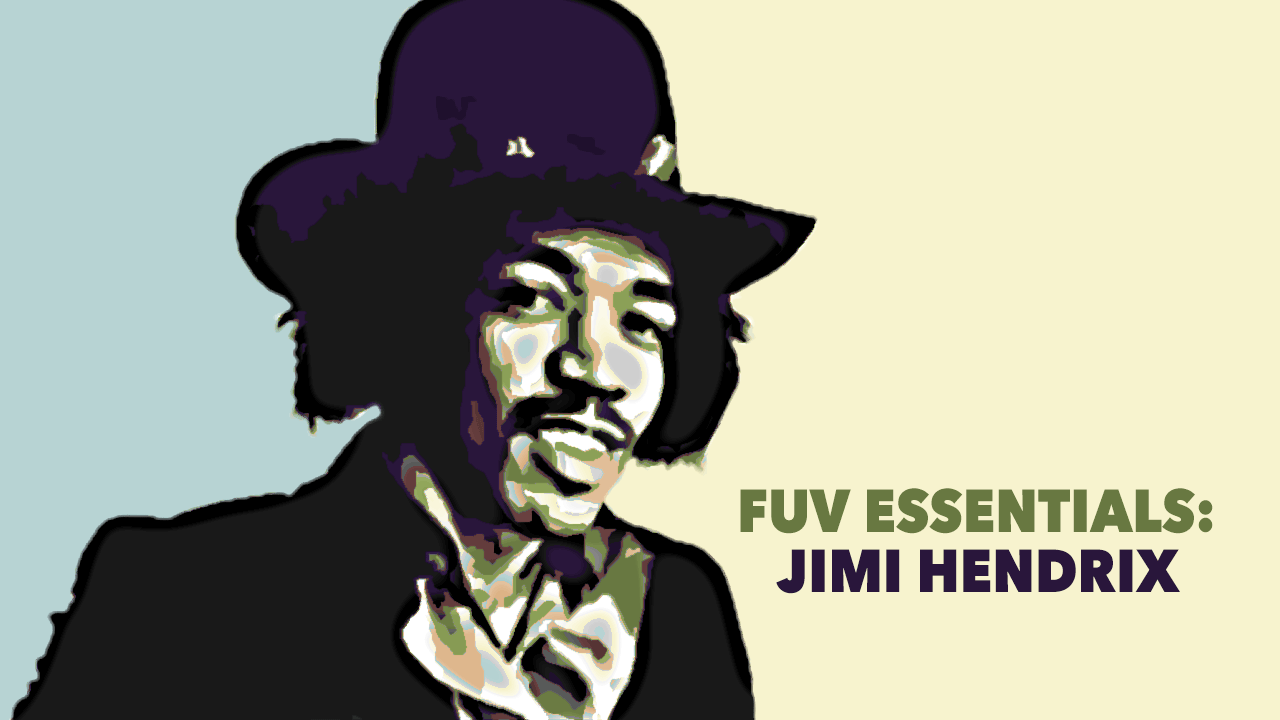Jimi Hendrix

Jimi Hendrix (image from promotional photo of the Jimi Hendrix Experience, via Wikimedia Commons)
A first-time immersion into the ecstatic sound orgy that is the Jimi Hendrix Experience's Electric Ladyland is an excursion to rock 'n' roll nirvana. The 1968 double album, which officially turns 50 on October 16, was the only release ever completely produced by Hendrix himself (after producer Chas Chandler quit) and it's likely the purest studio distillation of his mindset and experimental scope as a musician.
As anyone with even a rudimentary knowledge of rock music knows, Hendrix was one of the most inventive American guitarists of all time. Plenty of music fans would, without hesitation, proclaim him as the greatest to ever wrangle a Fender Stratocaster, reconfiguring what an electric guitar could do and how it could speak. He set a skyscraper-high bar for every brilliant guitarist who has followed in his wake, from Prince to Stevie Ray Vaughn to Bonnie Raitt.
On November 9, 2018, a deluxe box set edition of Electric Ladyland, remastered from the original analog tapes by Bernie Grundman and remixed in 5.1 Surround Sound by Hendrix's recording engineer Eddie Kramer, will be released with alternate takes, unreleased demos and outtakes, and an entire concert as a tasty bonus, Live at the Hollywood Bowl 9/14/68.
Leading up to Electric Ladyland's original release, Hendrix, along with the Experience's bassist Noel Redding and drummer Mitch Mitchell, was already an electrifying force via two albums that had come out the year before — the trio's debut, Are You Experienced, and Axis: Bold as Love, both recorded in London. But with Electric Ladyland, which evolved both in London and at New York's Record Plant, Hendrix was able to delve more deeply into the visceral, technically progressive musical language he was developing.
The guttural, backmasked preamble that swings open the gates of Electric Ladyland, "...And the Gods Made Love," lands the listener on the road that leads to the hazy groove of "Have You Ever Been (To Electric Ladyland)." It's an amiable welcome, buttressed by Hendrix's smooth, knowing croon.
But this album is no sleepy bromide — the next track, "Crosstown Traffic," hurtles headlong into the middle of a hectic city street, all funk and exhaust fumes, with Traffic's Dave Mason accompanying Hendrix on backing vocals. That noisy traffic jam melts into a long fade, which expands into the 15-minute heavy blues sacrament of "Voodoo Chile." Here, Hendrix's guitar mutters, barks, and sighs, dancing with Jack Casady's prowling bass and Steve Winwood's smoldering Hammond organ. There's laughing too, and smatterings of applause; we've drifted into a West Village club for a spell, it seems. Daydreamers can very nearly smell the smoke of cigarettes smoldering in ashtrays nearby.
All of this magic happens in just the first 20 minutes of one of the most consequential releases of its time — "Voodoo Chile" is later bookended by the album's epic finale, with the nimble "Voodoo Child (Slight Return)," that wah-wah pedal masterpiece with its slithering opening vamp. Track by track, Electric Ladyland remains a fresh revelation even today, sounding neither dated or overestimated in its impact. It's little stoned with an extra dose of that era's psychedelic bliss, sure. But as with all of Hendrix's recordings, he laid down a dazzling primer for every future guitarist to study, admire, and absorb.
"People talkin' but they just don't know, what's in my heart and why I love you so," Hendrix jauntily declares in his cover of Earl King's "Come On (Let the Good Times Roll)," perhaps one of Hendrix's best covers, even though his version of Bob Dylan's "All Along the Watchtower" gets most of the ravishing praise on Electric Ladyland. "Come On" had been one of Hendrix's favorite covers from his earliest days, when he played in high school bands in his Seattle hometown. The song's inclusion on Electric Ladyland is poignant in retrospect, since it symbolizes Hendrix's beginnings, the forthcoming end of the Experience on the horizon (Redding would leave the band by1969), and Hendrix's tragic death on September 18, 1970 at 27, just two years after the album's release.
During his lifetime, there were points of pain for Hendrix when it came to racial divides. Despite his reverence for African-American blues musicians, he struggled to make his own music connect to black audiences or radio. He was hassled by the law — a 1969 Rolling Stone interview casually mentions that he was frequently pulled over by the police whenever he drove from Woodstock, where he lived for a spell, to New York City. "Even the highway patrol exploits him," one of Hendrix's friends says. "They know his car: they stop him on the road between New York and Woodstock and harass him. Then they have something to gloat about for the rest of the day."
At the start of his career as a backing musician, Hendrix experienced virulent racism playing on the Chitlin Circuit, American venues where black musicians could perform during years of racial segregation. It drove him across an ocean. Only when he escaped to England, and settled in London, did he find the freedom and acceptance to excel as an artist, with encouragement and respect.
Anyone who ever saw the Jimi Hendrix Experience—or his Woodstock-era band, Gypsy Sun and Rainbows—perform in concert can absolutely claim ultimate rock cred. Imagine seeing Hendrix attack "Voodoo Child (Slight Return)" at the Atlanta Pop Festival on July 4, 1970, or resplendent in cornflower blue at the Newport Folk Festival on June 22, 1969. How amazing to catch him unfurling "Hey Joe" at Monterey Pop in 1967. He might have only been on earth for a fleeting moment in time, but Jimi Hendrix left a legacy of volcanic grace and brilliance that still roars like feedback from one of his amps.
And it's why Jimi Hendrix is absolutely one of our FUV Essentials artists.
Listen
#FUVEssentials: Jimi Hendrix (Spotify playlist compiled by FUV's Paul Cavalconte)

